Robert Cary Long Jr. (1810–1849) was the son of a late 18th Century - early 19th Century famous architect Robert Cary Long Sr. of Baltimore, Maryland and was himself a well-known 19th Century architect. Like his father, Cary was based in Baltimore.

St. Peter's Church and Mount St. Joseph Convent Complex is a Roman Catholic religious and educational complex on Convent and Meadow Streets in Rutland, Vermont. The complex includes a church, rectory, two schools, a convent, and an elderly housing building. It was listed on the National Register of Historic Places in 1980. The church is an architecturally significant work of architect Patrick C. Keely.

The Cathedral of Saint Mary of the Immaculate Conception is the cathedral of the Roman Catholic Diocese of Lafayette in Indiana. It is located at 1207 Columbia Street in Lafayette, Indiana. It is also a contributing property in the St. Mary Historic District.
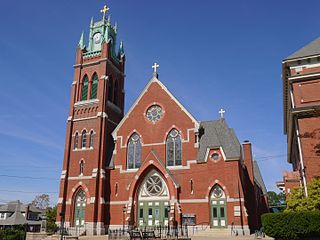
L'Église du Précieux Sang (also known as The Church of the Precious Blood is a historic Roman Catholic church complex at 94 Carrington Avenue and 61 Park Avenue in Woonsocket, Rhode Island, within the Diocese of Providence.

St. Michael's Roman Catholic Church, Convent, Rectory, and School is an historic Roman Catholic church complex at 251 Oxford Street in Providence, Rhode Island within the Diocese of Providence.

St. James Church is a historic Roman Catholic church located at 1826 Edenside Avenue in the Highlands section of Louisville, Kentucky. March 1, 1982, it was listed on the National Register of Historic Places as St. James Roman Catholic Church, Rectory, and School.

St. Mary's Roman Catholic Church Complex is a historic multi-building church complex at 133 School Street in Waltham, Massachusetts. Established as a parish in 1835, it is the city's oldest Roman Catholic establishment. Its 1858 Romanesque Revival church and 1872 Second Empire rectory are particularly fine architectural examples of their styles. The complex was listed on the National Register of Historic Places in 1989.

St. Boniface Roman Catholic Church was a Roman Catholic church located at 2356 Vermont Avenue in Detroit, Michigan. It was also known as St. Boniface-St. Vincent Roman Catholic Church. The church was designated a Michigan State Historic Site in 1983 and listed on the National Register of Historic Places in 1989, but was subsequently demolished in 1996. The church was removed from the NRHP in 2022.

The West Vernor–Springwells Historic District is a six block long commercial historic district located along West Vernor Highway between Honorah and Norman in Detroit, Michigan. The district includes 80 acres (32 ha) and 28 buildings. It was listed on the National Register of Historic Places in 2002.

St. Charles Borromeo Roman Catholic Church is a church located at the corner of Baldwin Avenue and St. Paul Avenue in Detroit, Michigan. The church address is 1515 Baldwin Street; ancillary buildings are located at 1491 Baldwin Street (Rectory) and 1480 Townsend Street. The complex was listed on the National Register of Historic Places in 1989.
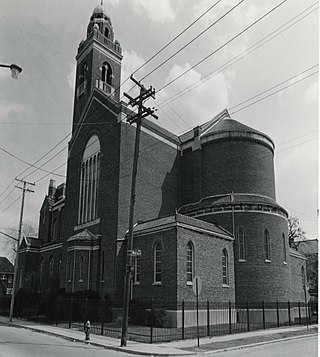
St. Thomas the Apostle Catholic Church was a church located at 8363 and 8383 Townsend Avenue in Detroit, Michigan. It was listed on the National Register of Historic Places in 1989, but was subsequently demolished.
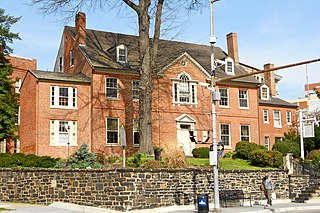
St. Paul's Church Rectory, located a block west of Old St. Paul's Episcopal Church is a historic Episcopal rectory located on steep "Cathedral Hill" at the northeast corner of Cathedral Street and West Saratoga Streets in downtown Baltimore, Maryland, United States. In the rear of the old rectory is a small alley-like extension of West Pleasant Street and to the east behind the North Charles Street former residences and now commercial structures, is another small alley extension of Little Sharp Street.

The St. Mary's Church Complex Historic District is a historic district located at the junction of Elm Avenue and North Monroe Street (M-125) in the city of Monroe, Michigan. It was listed as a Michigan Historic Site and added to the National Register of Historic Places on May 6, 1982.

Saint Peter the Apostle Church is a historic Roman Catholic church at 94 Somerset Street in New Brunswick, Middlesex County, New Jersey, United States.
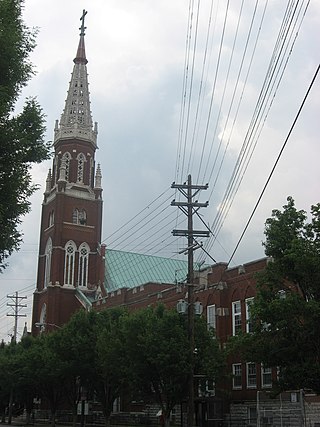
The former St. Anthony's Catholic Church is a redbrick historic Roman Catholic steepled church complex located at 2222-2238 West Market Street in Louisville, Kentucky. Designed by noted local architect William H. Redin in the Gothic Revival style of architecture, it was built in 1887. After a disastrous fire in 1939 which caused extensive damage to all buildings in the complex except the rectory to the left of the church, architect Walter C. Wagner, Sr. designed the reconstruction of the complex which was done by Skilton and Sullivan Construction Company. In 1978, the parish school was merged with St. Cecilia School and Our Lady of the Port Academy to form Community Catholic School on the St. Cecilia campus. On March 1, 1982, the complex was added to the National Register of Historic Places. In 2011, the Archdiocese of Louisville closed the church, merging its boundaries into those of the nearby Good Shepherd Parish.

St. Mary's Catholic Church is a parish of the Archdiocese of Dubuque. The church is located in Guttenberg, Iowa, United States. It is listed on the National Register of Historic Places as St. Mary's Catholic Church Historic District. In addition to the church, the historic district includes the parish rectory, convent, and school building.
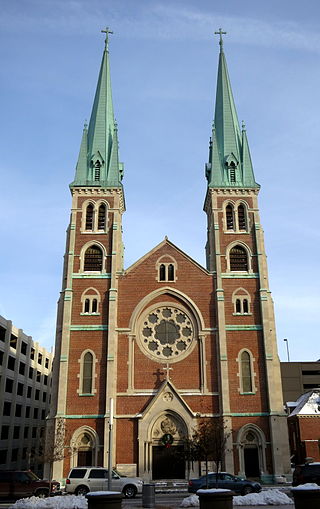
Saint John the Evangelist Catholic Church is a Roman Catholic parish of the Archdiocese of Indianapolis in Indianapolis, Indiana, United States. The parish's origins date to 1837, when it was first named Holy Cross parish. In 1850 it was renamed Saint John the Evangelist parish, and is the oldest Catholic parish in the city and in Marion County, Indiana. Considered the mother of the Catholic parishes in Indianapolis, it played an important role in development of the Catholic Church in the city. Saint John's Church served as the pro-cathedral of the diocese from 1878 until 1906; its rectory served as the bishop's residence and chancery from 1878 until 1892. In 1900 the church served as the site of first episcopal consecration held in Indianapolis.

James J. Gaffney, most often known as J. J. Gaffney, was an American architect in Louisville, Kentucky.

St. Joseph's Catholic Church is a historic Roman Catholic church building located at 290 NW Church Street in Krebs, Oklahoma, United States. The first church building, was constructed of wood in 1886. It burned down in 1902, and a new brick structure was built in 1903 and added to the National Register of Historic Places (NRHP) in 1980.

St. Andrew's Catholic Church is a historic Roman Catholic church and rectory in Roanoke, Virginia, United States. It was built in 1900-1902, and is a buff brick church on a stone foundation in the High Victorian Gothic style. It has a cruciform plan and features two tall Gothic towers which flank the main entrance and are square in plan. On each tower are two small lancet windows, two large pointed-arch stained-glass tracery windows, and sets of double pointed-arch openings at the belfry. Also on the property is a rectory built in 1887. The church replaced an earlier small brick church built in 1883.





















